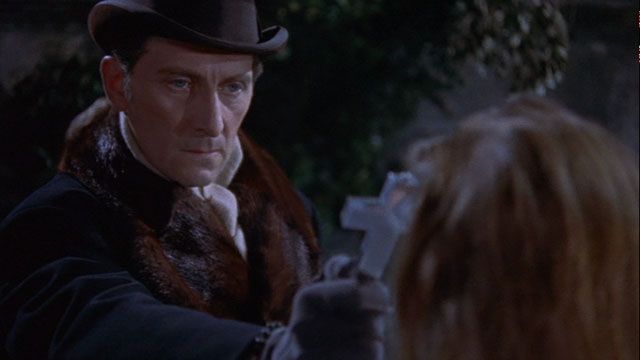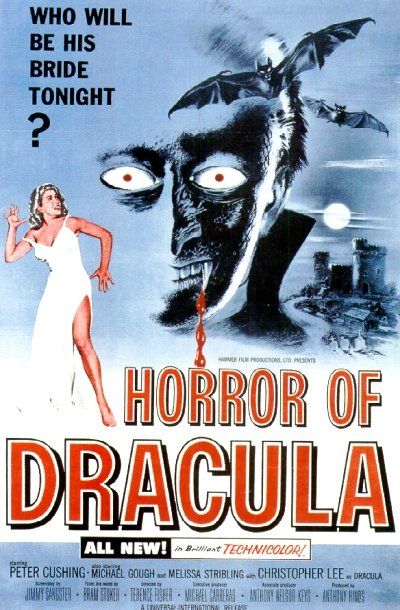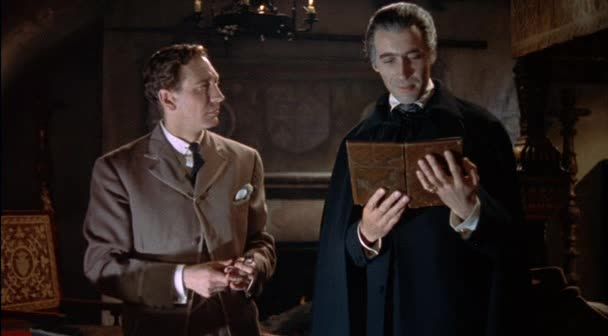Horror of Dracula
1958
Director: Terence Fisher
Starring: Christopher Lee, Peter Cushing, Michael Gough
Vampire myth and legend has been squarely in the public consciousness for more than a century. While Bram Stoker’s novel Dracula was hardly the first incidence of vampires in fiction, it was perhaps the most successful, and with such recent additions as *shudder* Twilight and Abraham Lincoln: Vampire Hunter, vampires still continue to fascinate, whether they sparkle or no. In the 1950s, possibly the most iconic vampire film comes from the fabled Hammer studio of England, Horror of Dracula.
Inspired by but hardly faithful to Bram Stoker’s original novel, the movie tells the story of first Jonathan Harker (John Van Eyssen) and then Van Helsing (Cushing) as they track and stalk the vampire Count Dracula (Lee). Harker tries his hand at destroying Dracula by going out to the Count’s castle on his own, but he is quickly overcome by the Count and his female underling. We then cut back to Harker’s fiancée Lucy, who is sickly because she too is being haunted by the Count. Van Helsing explains to Lucy’s brother Arthur (Gough) that she must be protected from the vampire as well.
Hammer Horror is one of the most famous horror studios of all time, putting out a tremendous number of films for decades. Horror of Dracula was hardly their first film, the studio having been making films since the 1930s, but the studio underwent a rebirth in the fifties, one that was helped along greatly by the tremendous box office success of this movie. This rebirth helped to define what has now become recognizable as the trademarks of Hammer Horror.
Perhaps most notable of these trademarks is the production value of these films. Hammer films have a very distinctive look, a look that is summed up perfectly in Horror of Dracula. While early American horror films are all about shadow and light, black and white, Hammer Horror is shot in rich, lush Technicolor. The colors are so bright, the film reminds me of the classic MGM musicals of the forties and fifties. Lucy’s nightgown is a brilliant teal green, the vampire blood is bright red, Harker’s coat is a blazingly cobalt blue, the main door to Arthur’s house is emerald green… the list goes on and on. While horror films are infrequent in their use of color, it’s not completely unheard of. Consider what Mario Bava did with his Italian horror films of the 1970s, complete with splashes of neon color, or what Kubrick did in The Shining, or the insane but colorful dreamscape of A Nightmare on Elm Street. These films all probably owe a bit of a debt to the color work in the Hammer films.
But it’s not just the colors that make Hammer Horror and Horror of Dracula distinct, it’s the rest of the production as a whole. The sets and costumes are incredibly distinct. Nearly the whole of the film was shot on soundstages, with only a few small scenes using outside locations. This gives the film a feeling of artifice that, oddly enough, helps. Heck, we know that vampires aren’t real, so why should this film try to pretend that they are? Just join in the storybook world of the film and you’ll have a swell time. Dracula’s castle is easily the most artificial, and the best set in the film. The checkerboard marble floor, the pink and white gilded fireplace, the white marble curly columns, the expansive hallways – this is a rich, luxurious, and completely fake set. It’s utterly fantastic.
My mention of MGM musicals earlier wasn’t coincidental. One of the reasons why Horror of Dracula works for me as well as it does is because of its similarity in looks to that particular genre of films, a genre I love very much. Combine an aesthetic that evokes very particular feelings for me, but then combine it with the utterly gothic horror fantasy element of Dracula, and you have something that is both peculiar and beguiling.
One of my other sources of entertainment in this film is the fact that it stars Christopher Lee, Peter Cushing, and Michael Gough. All three actors had full and varied careers, and yet all I can do every time Peter Cushing is on screen is think “IT’S TARKIN!” Ditto for Michael Gough – “IT’S ALFRED!” At the very least, Christopher Lee is iconic to me as, well, Christopher Lee, and Lee playing Dracula is exactly what I picture. Is this fair to Cushing or Gough? No, it’s not; it’s not fair that I only reference one particular role for each of them. Yet, in a bizarre way, it helps me enjoy the movie, giggling at seeing these actors much younger, with much more frou-frou costumes (Cushing pulls off a pretty awesome crushed red velvet suit at one point), behaving not at all like their other roles. I can’t help but giggle at it.
 |
| Tarkin is rockin' that fur collar, yo. |
Movie Guy Steve pointed out to me in a facebook chat to notice how few lines Christopher Lee has in this film. In checking with iMDB, there is, in fact, only 13 lines that Lee speaks, and he speaks them all to Harker at the beginning of the story. After Harker is disposed of, all Dracula does is show up occasionally and stare menacingly at other people. For a movie called Horror of Dracula, Dracula is in the film surprisingly little. In many ways, this is like Harry Lime in The Third Man - everyone talks an awful lot about him, but we don’t see him very much. He is the driving force of the film, the motivation behind everything, but goodness, he can’t be onscreen for longer than ten minutes. Having said that, Christopher Lee makes the most out of those thirteen lines and ten minutes. He manages to completely embody Dracula and lend the central fear to the film.
For the 1950s, Horror of Dracula was particularly gory and gruesome; seeing the blood in bright, vivid Technicolor was considered shocking at the time. Is it still gory and gruesome? Heavens no, but it’s definitely an improvement on Tod Browning’s 1931 Bela Lugosi Dracula. That original Dracula is iconic because of its historical significance, but it’s rather dull today. Horror of Dracula is much more entertaining, even if it isn’t particularly frightening. Easily one of the best improvements from Browning’s “original” to this is the smart inclusion of Dracula’s demise at the end of the film. In 1931, we were treated to an off-screen destruction of Dracula, something that feels tremendously anticlimactic. There is a much more satisfying finish to the Count in this film, with easily the best special effects of the film. Dracula is slowly and tortuously turned to dust by the victorious Van Helsing, and we get to actually see this. This undoubtedly would have been shocking and gruesome in the fifties. While hardly so today, it’s still an effective end to our villain.
Is Horror of Dracula scary? Not to me it’s not. Is it entertaining? Hell yes. It’s over the top and gothic and melodramatic, but in a good way, and one of the most fun horror movies I can think of.
Arbitrary Rating: 7/10


I like this film for what it is. Lee and Cushing, and vampires, and campy joy. Lee really is pretty damn awesome. I love that he's been so firmly and joyfully embraced by the larger film community in recent years.
ReplyDeleteYeah, this isn't scary, but it's kind of risque for its time, and it's a massive load of fun.
Exactly. I put this film in the same category as something like "Forbidden Planet."
Delete"Campy joy" for the win!